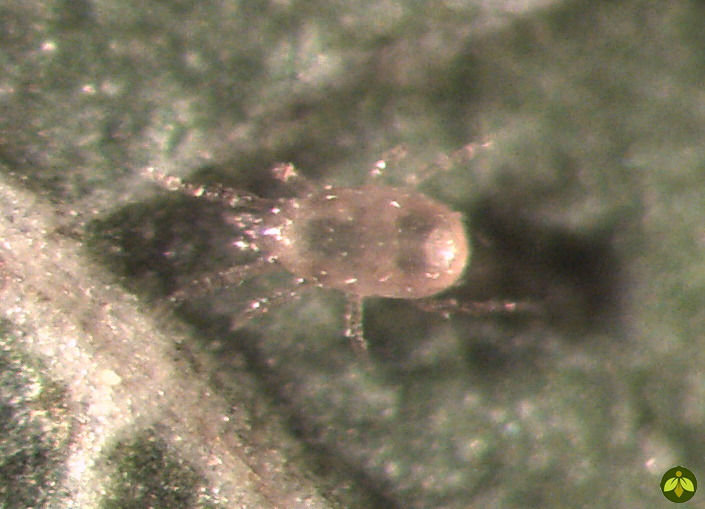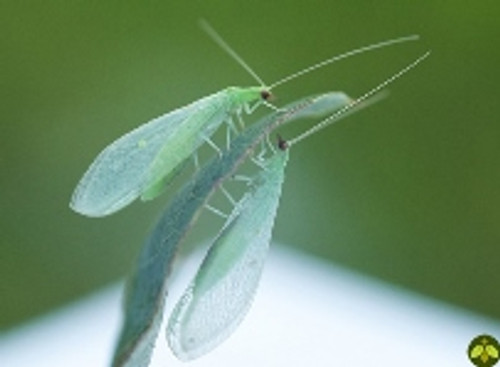Description

Amblyseius (=Neoseiulus) cucumeris, the thrips predatory mite, are useful for the prevention, control, and management of various thrips species. A. cucumeris are tough, flexible predators that happen to prefer thrips, mostly the immature thrips stages. These predators are supplied two different ways: a bulk product in vermiculite for fast distribution and consumption; and a sachet product for slow preventive releases over an 5-7 week period (depending on greenhouse conditions). Some of the species they can devour include: the western flower thrips (Frankliniella occidentalis); the flower thrips or eastern flower thrips (F. tritici); the onion thrips (Thrips tabaci); the greenhouse thrips (Heliothrips haemorrhoidalis); and possibly the melon thrips (Thrips palmi), too. Other pests which can be impacted by these predators include cyclamen mites (Phtyodromus =Steneotarsonemus pallidus), broad mites (Polyphagotarsenomus =Hemitarsonemus latus) and, to a slight degree, tomato russet mite (Aculops lycopersici). And, as an Amblyseius spp., these predators may eat other pests as well.
Life-style
The tiny 0.5 mm. clear-white adult female mites lay eggs amongst thrips concentrations. They can lay up to 35 eggs. The eggs hatch into super small larvae which develop into nymphal forms before reaching adulthood. These, too, are fierce predators, consuming many immature thrips. The life-span of these predators is about 10 days in their immature stages, then around 30 days as adults. The conditions for optimum performance will be between 66-80°F with a relative humidity of between 65-72%. But these are optimum conditions, and not necessarily a prerequisite of successful implementation. Please note, however, considerably cooler temperatures will hamper reproduction and development to a certain degree.
Benefits
AMBLYforce™ C is very cost-effective. These predators enjoy snacking on available pollen. This helps them be an efficient long-term preventive agent as well as a curative one. And, when supplied in slow-release packets, they are even more outstanding. The sachets, which normally last 4 weeks, contain a food source for the predators: a bran mite or, more properly, the mold mite (Tyrophagus putrescentiae). This mold mite is merely a sustainable food source for the predatory mites while they’re in transit, and longer in the sachet system.These mites are very, very economical. So economical, in fact, some growers are using A. cucumeris as they would a pesticide: the infamous repeated dousing technique. Speaking of pesticides, these predators are compatible with many; a real plus in an Integrated Pest Management (IPM) program. Lastly, this is the only commercially produced A. cucumeris in the US. Any other A. cucumeris product will have spent days traveling from Canada or Europe.
Drawbacks
You get a lot, but you have to use a lot. Good thing they’re inexpensive. The sachets are great, though more expensive, they do the preventive job assigned to them. The problem is when growers want to use them for control in an environment where the loose material is impractical to apply: certain hydroponic systems, for example where the bran carrier may fall into a trough. The drawback is they’re not designed to work that way. Slow release in the case of these sachets means that the resident generation usually doesn’t venture out of the bag. Their offspring, however, begin the process of prevention as they start exploring the world outside.
Scouting
Finding A. cucumeris on the plants is difficult. To the beginner I suggest simply monitoring the thrips levels. This is much easier than looking for predators all day. Monitoring thrips levels can be done two different ways:
- Use blue or yellow sticky traps to capture adults which can be counted weekly and/or;
- Use the “paper method” by gently shaking the plant over a white piece of paper on which they’ll show up nicely.
Try the latter on a corn plant this summer, tap out the tassels if you really want to see some thrips. Unless your scouting is really top-notch, you’ll probably miss most of the predators present on the leaves. However, if you see some agile-looking mites running a zigzag quickly across the leaf’s undersurface, they are probably predators.
Advisories
Flowering, pollen producing plants are a big plus so certain crops may prove beneficial. Humidity: the packets can develop a growth of some sort about two weeks after they were put out in humid conditions (90% and up).
There may be a compatibility issue when used with Phytoseiulus persimilis. Used together, these pairs are under suspicion: the A. cucumeris may eat the other predators’ eggs. Before getting some loose bran product, determine how it’s going to be applied so that you can prepare. Beside shaking out the bulk bran onto the leaves, you may wish to apply it with a broadcast granule or whirlybird type spreader.
Another compatibility issue may exist with Dalotia coriaria. If used together, we strongly suggest using the A. cucumeris sachets instead of the bulk bottles.
Usages
Greenhouses/interiors are where these mites are most often used. Hemp Russet Mite (Aculops cannibacola) and Broad Mite (Polyphagotarsonemus latus)
• Due to microscopic size, early detection is critical for Hemp Russet and Broad Mites
• “Vagrant” feeding on plant tissue causes varying symptoms often misdiagnosed as nutrient deficiencies
• Current management strategies are the same for both species of mites
• Broad mite eggs have a distinct dimpled “jeweled” appearance (a target when scouting)
• BCAs include: N. fallacis, N. californicus, A. andersoni, A.cucumeris
Western Flower Thrips (Frankliniella occidentalis)
• The Western Flower Thrip (WFT) is an overlooked pest in many cannabis grows as it is not as destructive to cannabis as many other crops, but still has the potential to spread incurable plant viruses causing significant crop losses
• The WFT completes the pupal life stages below soil/media = mix of BCAs needed to break life cycle.
• BCAs include: O. insidiosus, A. cucumeris, S. scimitus, D. coriaria, S. feltiae, C. rufilabris*
Release Rates for AMBLYforce™ C
| Classification | Release Information |
| Bottle or Bulk Bag | 5-10 per sq. ft, repeat weekly or bi-weekly as needed. |
| Slow release sachets | 1 sachet per 10 sq. ft. but may be increased to one sachet per plant in some crops. |








